Albert Eckhout
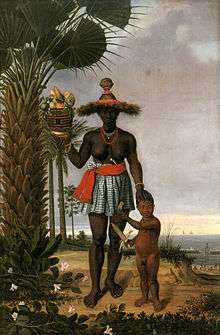
Albert Eckhout (c.1610–1665) was a Dutch portrait and still life painter. Eckhout, who was born in Groningen, was among the first European artists to paint scenes from the New World. In 1636 he traveled to Dutch Brazil, where he stayed until 1644, invited by count John Maurice, Prince of Nassau-Siegen.[1] There, he painted portraits of the natives, slaves and mulattos of Brazil in the seventeenth century, besides numerous sketches of plants and animals.[2]
Eckhout is also famous for his still-life paintings of Brazilian fruits and vegetables. The majority of his work is now located in the National Museum of Denmark in Copenhagen. In art history, he is taken to be part of Baroque. Minor planet 11241 Eckhout is named for him.
Work in Dutch Brazil
Eckhout was born in Groningen, the son of Albert Eckhout and Marryen Roeleffs, but his training as an artist and early career are unknown. Many works attributed to him are unsigned. He was in the entourage of Dutch governor-general of Brazil Johan Maurits, Prince of Nassau-Siegen, who took him and fellow painter Frans Post to Dutch Brazil to have them record the country's landscape, inhabitants, flora and fauna.[3] Eckhout focused on the people, plants and animals of the region. He painted eight life-size ethnographic representations of Brazil's inhabitants, twelve still lifes and a large piece of dancing natives.
These ethnographic works, done between 1641 and 1643 for Maurits, were subsequently gifted to Maurits's cousin, King Frederick III of Denmark, and they remain in Copenhagen. Alexander von Humboldt saw the paintings in 1827, as Brazilian Emperor Dom Pedro II in 1876, both of whom praised them enthusiastically.[4]
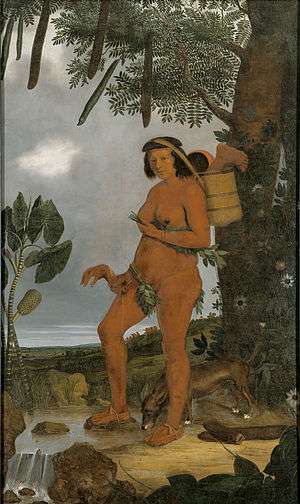
While Post was focusing on painting maps and landscapes, Eckhout made pieces about the inhabitants and still lifes with fruits and vegetables.[1] His work is said to give the first realistic image of the native population, part of the Tupi and Tapuia tribes. One of his famous works is of a calmly composed Tupian woman, who holds a human hand and has a human leg in her basket, an example of cannibalism. The Tapuya dance, performed by eight Tapuia Indians with their characteristic mushroom hair style, cudgels and spears, deals with the preparation for the confrontation with the enemy. This picture was much more in accordance with the mental image of the natives back in Europe.
Another famous work of art by Eckhout from his time in Brazil is the Mameluca Woman. This is a depiction of a woman in a flowing white dress balancing a basket of flowers in one hand. Her other hand is lifting her dress to reveal a small portion of her leg. She is believed to be a mix of European and the indigenous people of Brazil given by the title “Mameluca.” This painting has many aspects that were characteristic of Eckhout's other paintings from his time in Brazil. The two guinea pigs at the woman's feet show his interest in the natural life of Brazil. In addition the flowers that she is carrying and the plant life around her were Eckhout's way of representing the fertility of Brazil and drawing attention to the successful production of crops there.[5]
For a couple of reasons, the series of twelve still-life paintings by Albert Eckhout are unique. First, they show Brazil's abundant crops and second, these are the only known still-life paintings from the seventeenth century showing an overcast sky in the background.
Gallery
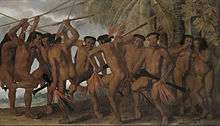 Tapuias dancing
Tapuias dancing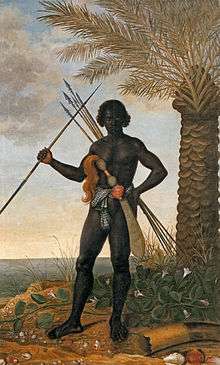 African warrior at the time of Ganga Zumba, leader of the Quilombo of Palmares
African warrior at the time of Ganga Zumba, leader of the Quilombo of Palmares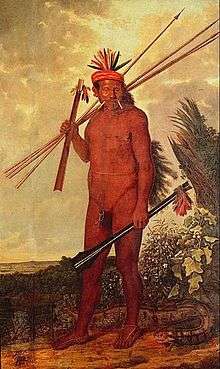 Brazilian Indian warrior
Brazilian Indian warrior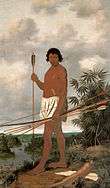 Brazilian warrior with traditional bow and arrows and a European knife
Brazilian warrior with traditional bow and arrows and a European knife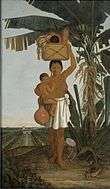 Tupian woman with baby, fruiting banana tree, and European plantation in background
Tupian woman with baby, fruiting banana tree, and European plantation in background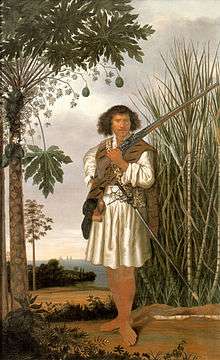
 Dom Miguel de Castro, emissary of Kongo
Dom Miguel de Castro, emissary of Kongo Servant of Dom Miguel de Castro with a decorated box
Servant of Dom Miguel de Castro with a decorated box Servant of Dom Miguel de Castro with elephant tusk
Servant of Dom Miguel de Castro with elephant tusk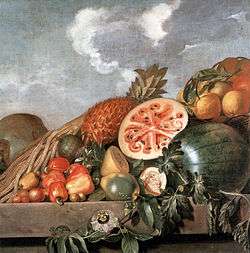 Still Life with Watermelons, Pineapple and Other Fruit
Still Life with Watermelons, Pineapple and Other Fruit Still Life with Manioc
Still Life with Manioc Still Life with coconuts
Still Life with coconuts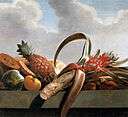 Pineapple, papaya, and other fruits
Pineapple, papaya, and other fruits Pumpkins and melons
Pumpkins and melons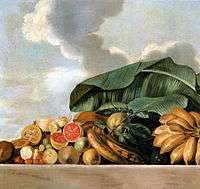 Bananas, guava, and other fruits
Bananas, guava, and other fruits



See also
References
- 1 2 Maria Burguete, Lui Lam (2011). Arts: A Science Matter, Vol. 2. World Scientific. p. 53. ISBN 981-4324-93-0.
- ↑ See Ernst van den Boogaart's article in The Slave in European Art: From Renaissance Trophy to Abolitionist Emblem, ed Elizabeth McGrath and Jean Michel Massing, London (The Warburg Institute) and Turin 2012.
- ↑ Francis A. Dutra, "Albert Eckhout" in Encyclopedia of Latin American History and Culture, vol. 2, p. 430. New York: Charles Scribner's Sons 1996.
- ↑ Dutra, "Albert Eckhout", pp. 430-31.
- ↑ Buono, Amy. "Interpretative ingredients: formulating art and natural history in early modern Brazil". proquest.com. Retrieved 2017-03-04.
Further reading
- Alpers, Svetlana. "The Art of Describing Albert Eckhout" in Albert Eckhout volta ao Brasil / Returns to Brazil: 1644-2002. Simposio Internacional de Especialistas / International Experts Symposium. São Paulo: Donigraph 2002, 355-8.
- Berlowicz, Barbara. Albert Eckhout volta ao Brasil / Returns to Brazil (1644-2002). Copenhagen: Nationalmuseet 2002.
- Boogaart, Ernse van den. "The Population of the Brazilian Plantation Colony depicted by Albert Eckhout, 1641-1643" in Barbara Berlowicz, ed. Albert Eckhout volta ao Brasil / Returns to Brazil (1644-2002). Copenhagen: Nationalmuseet 2002, 117-31.
- Buvelot, Quentin, ed. Albert Eckhout: A Dutch Artist in Brazil. Zwolle: Waanders 2004.
- Dutra, Francis A. "Albert Eckhout" in Encyclopedia of Latin American History and Culture. New York: Charles Scribner's Sons 1996, vol. 2, pp. 430-431.
- Joppien, R., "The Dutch Vision of Brazil: Johan Maurits and his Artists," in Johan Marutis van Nassau-Siegen, 1604-1679, edited by E. van den Boogart (1979)
- Parker Brienen, Rebecca. Visions of savage Paradise: Albert Eckhout, Court Painter in Colonial Dutch Brazil. Amsterdam: Amsterdam University Press 2006.
- ______, Albert Eckhout: Visões do Paraíso selvagem -- Obra Completa. Rio de Janeiro: Editoria Capivara 2010.
- Prado Valladares, Clarival do and Luiz Emgydio de Millo Filho, Albert Eckhout: Pintor de Mauricio no Brasil, 1637-1644. (1981)
- Thomsen, Thomas. Albert Eckhout, ein niederländischer Maler und sein Gönner Johan Maurits der Brasilianer: Ein Kulturbild aus dem 17 Jahrhundert. Copenhagen: Levin and Munksgaard 1938.
- Whitehead, Peter J.P. and Marinus Boesman, A Portrait of Dutch 17th century Brazil: Animals, Plants, and People by the Artists of Johan Maurits of Nassau. Amsterdam: North-Holland Publishing 1989.
External links

- Eckhout on the site of the National Museum of Denmark in Copenhagen
- Esther Schreuder - art historian